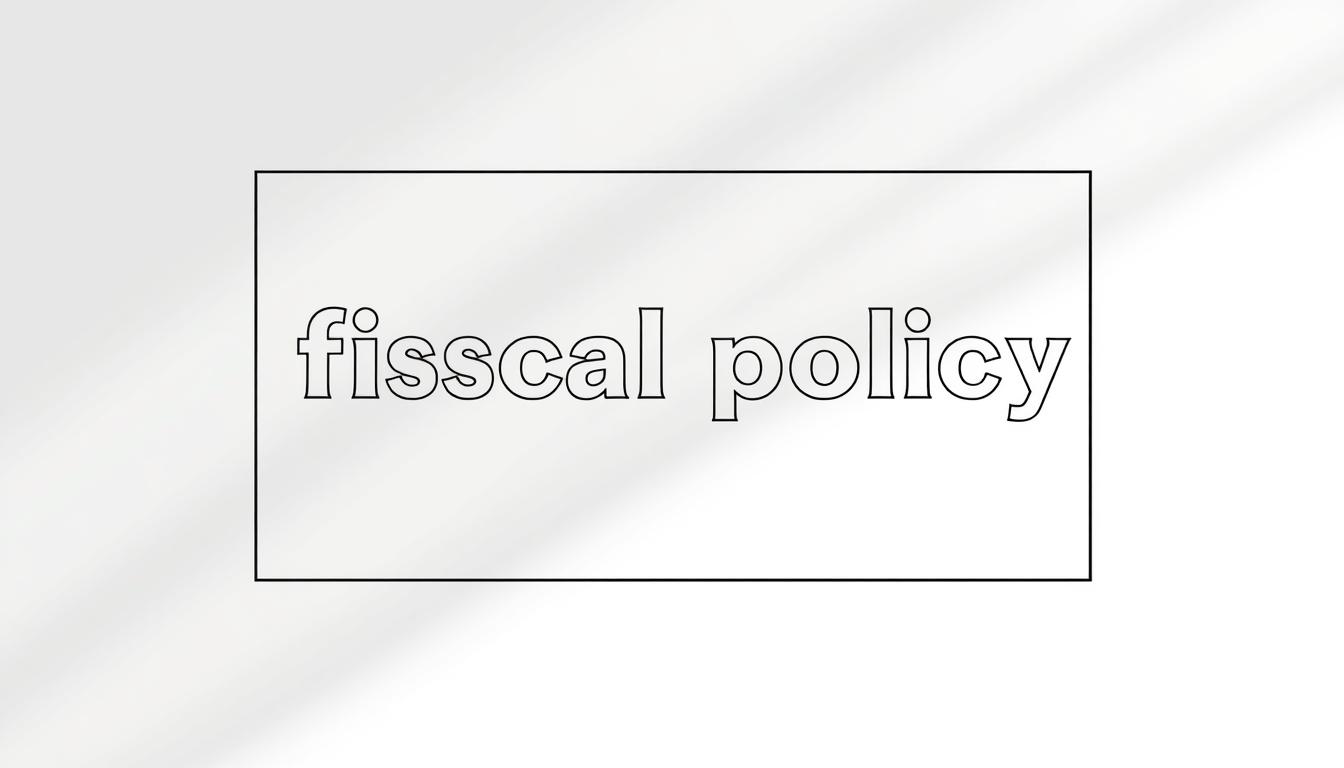Fiscal policy is key in shaping the U.S. economy. It uses government spending and taxes to stabilize and grow the economy. This article will discuss how fiscal policy works, aiming for stability, fair resource sharing, and prosperity. We will cover different fiscal strategies, their effects on growth, and implementation challenges.

GBTI Visa Gold Card

What Is Fiscal Policy?
Fiscal policy is key to shaping a country’s economy. It involves government spending and taxing decisions. These efforts aim to control job levels, inflation, and how fast the economy grows. By doing this, the goal is to keep the economy stable, create more jobs, and improve people’s lives.
Anúncios
Definition and Core Objectives
Fiscal policy is a way to steer the economy. It uses government spending and taxation to reach its goals. These goals include making the economy stable, increasing jobs, and boosting public well-being.
Anúncios
- Stabilizing economic fluctuations throughout different cycles.
- Promoting job creation during times of economic distress.
- Enhancing public welfare by improving service delivery and infrastructure.
Key Components of Fiscal Policy
Two main parts make up fiscal policy: government spending and taxation. Government spending helps spur the economy, especially in tough times. Taxation adjusts to either encourage or lessen spending and investment.
By adjusting these areas, governments work towards economic stability and growth. Experts say that fiscal policy is a powerful way to balance the economy.

The Importance of Fiscal Policy in Economic Stability
Fiscal policy is key to keeping the economy stable. Governments can shape our economic health by adjusting spending and taxes. These actions affect what businesses invest in and what we buy.
By understanding fiscal policy, we see its role in controlling the economy. It helps manage economic activity and keeps the economy from big ups and downs.
Regulating Aggregate Demand and Economic Output
To control economic demand, governments use fiscal policy. When the economy is down, they can spend more or lower taxes. This creates more demand, which helps the economy grow.
But if prices start to climb too fast, they’ll spend less or raise taxes. This slows down the economy a bit. Adjusting fiscal policy is key to keeping the economy balanced.
Mitigation of Economic Fluctuations
Fiscal policy aims to smooth out economic ups and downs. The Great Depression showed the power of government action. It helped stabilize economies that were struggling.
By deploying fiscal tools, governments can tackle tough times. This lessens the bad effects of economic swings. It makes our economy stronger and more steady.
Types of Fiscal Policies
Government strategies to manage the economy include expansionary and contractionary fiscal policies. These methods serve different economic conditions. They aim to either boost growth or manage inflation. Knowing how these policies work is key to understanding their economic impact.
Expansionary Fiscal Policy: Definition and Objectives
Expansionary fiscal policy involves government action to spark economic activity, especially in downturns. It might mean more government spending or lower taxes to increase demand. The goal is to lessen unemployment and encourage people to spend more, leading to growth.
Contractionary Fiscal Policy: When and Why It’s Used
Contractionary fiscal policy, on the other hand, aims to slow down the economy. It does this by cutting government spending or raising taxes. This approach helps control inflation and excessive demand. It’s used when the economy grows too fast, which can cause prices to surge. Knowing when and why to use this policy is vital for maintaining economic stability.
Effects of Fiscal Policy on Economic Growth
Fiscal policy greatly influences economic growth. It has effects seen in both short and long terms.
Governments can use it to boost employment and stimulate demand. This helps with economic recovery and stability.
Short-Term Impacts on Employment and Demand
In the short term, effective fiscal policies can raise employment levels. Government spending on projects like infrastructure creates jobs quickly. This spending also boosts overall demand, very important during recessions.
Jobs lead to more consumer confidence and spending, helping the economy grow.
Long-Term Benefits from Government Investment
Long-term growth comes from smart government investments. Putting money into education and technology improves skills and productivity.
This makes the economy more competitive and supports lasting growth. So, the economy’s overall capacity gets better, boosting jobs and life quality.
Strategies for Effective Fiscal Policy Implementation
For effective fiscal policy, a proactive approach is key. This means planning for now and the future. Using countercyclical strategies is important for economic stability. These strategies involve adjusting government spending and taxes based on the economy’s state. Doing so builds fiscal resilience.
When the economy is down, boosting spending can help stimulate demand and aid recovery. On the flip side, cutting spending during growth periods can prevent the economy from overheating.
Countercyclical Fiscal Policies
Countercyclical fiscal policies are tools to smooth out economic ups and downs, crucial for sound fiscal policy. By increasing spending during recessions, governments can lessen the blow of reduced consumer demand. Finding the right level of action requires careful thought to ensure spending meets the economy’s immediate needs. These policies, when used well, can make the economy more stable.
Prioritizing Public Investments for Sustainable Growth
Investing in public assets is key to ensuring ongoing economic health and growth. Focusing funds on infrastructure, education, and technology lays groundwork for progress. These areas boost productivity, spark innovation, and enhance community well-being. It’s also vital to re-evaluate current spending to ensure wise use of resources, aiming for lasting economic gains.
Ensuring these investments align with sustainable methods supports our broader economic goals. This approach contributes to strong, sustained growth.
Fiscal Policy vs. Monetary Policy
Fiscal policy and monetary policy are key for managing the economy well. The government uses fiscal policy through choices about taxes and public spending. Its goal is to impact the economy by changing how much the government spends and taxes. Monetary policy, however, is run by the central bank. It aims to control the money supply and interest rates. These are important tools to keep the economy stable.
Understanding the Differences
Fiscal policy and monetary policy have different goals and ways of working. Fiscal policy works to manage economic activity by how the government spends and taxes. It affects things like public services and roads. Monetary policy, though, focuses on keeping prices stable and promoting healthy economic growth. It does this by adjusting interest rates and how much money is out there. The government is very involved in fiscal policy. But the central bank handles monetary policy with a more technical approach.
How They Work Together
It’s important for fiscal and monetary policies to work in sync for solid economic health. For example, when the government increases spending and the central bank sets low-interest rates, their effects are stronger together. This teamwork makes sure fiscal actions support bigger economic goals. It leads to a smart way of handling the economy. Knowing how both policies work helps people tackle economic issues and push for lasting growth.
Challenges in Implementing Fiscal Policy
Making effective fiscal policy work is tough. Political pressures make the decision-making process complicated. Leaders often have to choose between pleasing voters now or making tough decisions for long-term stability. People’s opinions matter too. When it comes to raising taxes or cutting spending, how the public feels can really sway the outcome.
Political Pressures and Public Perception
Political pressures can twist what it means to have a solid fiscal policy. Sometimes, leaders focus more on being liked in the short term. This can lead to decisions that don’t really solve economic problems. As people’s views change, getting them to agree with tough decisions gets harder. If people don’t like a policy, putting it into action can be tough. This makes achieving a good fiscal policy even more challenging.
The Risk of Unsustainable Debt Levels
Rising debt is a big hurdle for fiscal policy. When a country owes too much, it loses the ability to deal with future problems. Too much debt means more money spent on interest. This takes away from important services and investments. It’s key for leaders to find a balance. They need to encourage growth but also keep the country’s finances healthy to avoid harming the economy.
The Role of Government Spending and Taxation
Government spending and taxation shape a country’s economy. Managing them well can improve the economy, increase jobs, and make society fairer. They affect economic health and growth chances.
Impact of Government Expenditures on Economic Performance
Government spending is key to boosting the economy. It funds infrastructure, education, and healthcare. These investments create jobs and better public services, boosting demand.
This demand boosts activity in different parts of the economy. It leads to better growth rates and stability.
Taxation as a Tool for Economic Redistribution
Taxes do more than just fund public services. They help redistribute income, making sure rich people pay their fair share. This helps fund social programs for those with less, making society more equal.
This way, more people can join in the economy. It makes the whole economy do better.
Variable Private Sector Behavior and Fiscal Policy
The way private sector acts and fiscal policy are linked is key to getting economic dynamics. When people feel confident, they spend more. This shapes the economy. Policymakers need to catch these mood changes to craft smart fiscal plans.
The Influence of Consumer Confidence on the Economy
How people feel about the economy matters a lot. If they’re upbeat, they spend more. This boosts demand and growth. But if they’re worried, they cut back on spending. This can slow the economy down.
- High consumer confidence usually means more spending by households.
- When confidence drops, spending on extras goes down.
- The private sector adapts, changing how they operate and invest based on how consumers act.
Understanding these ties helps predict how fiscal policy might stabilize the economy. To make policies work better, it’s vital they reflect what people feel. This helps in making strategies more effective.
Conclusion
Fiscal policy is key in managing the economy. It needs careful planning, smart action, and ongoing review. It affects many things, like job rates and how fair the economy is. Finding the right mix between government spending and taxes is important. This balance helps the economy grow steadily and stay stable.
The future of fiscal policy looks full of challenges. Leaders must learn from the past but also adapt to new economic problems. Creating policies that can handle changing situations is very important. So, having a fiscal policy that is both flexible and responsible is essential. It helps in dealing with the complex nature of today’s economy.
FAQ
What is the primary purpose of fiscal policy?
How does fiscal policy regulate aggregate demand?
What are the two main types of fiscal policies?
Why is government spending crucial in fiscal policy?
How does taxation play a role in fiscal policy?
What challenges does fiscal policy face during implementation?
How does consumer confidence affect fiscal policy effectiveness?
What role do countercyclical fiscal policies play?
How does fiscal policy interact with monetary policy?
Conteúdo criado com auxílio de Inteligência Artificial


